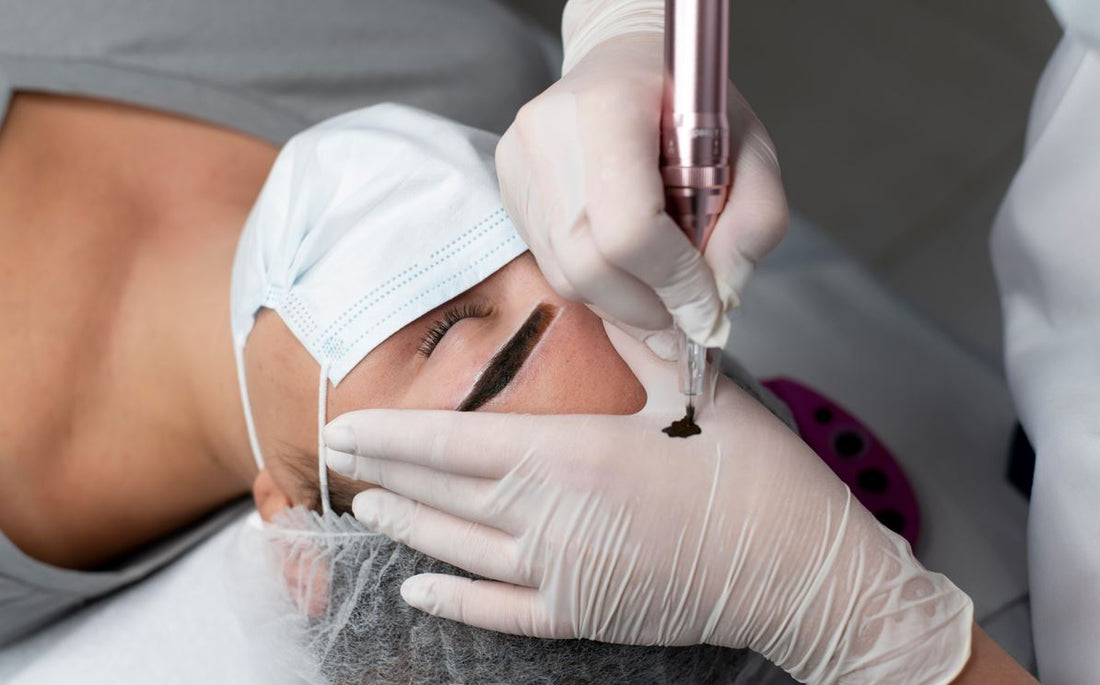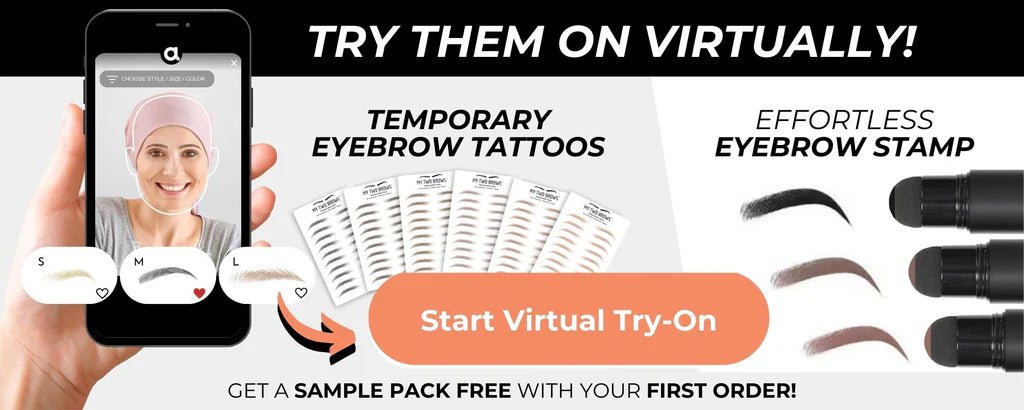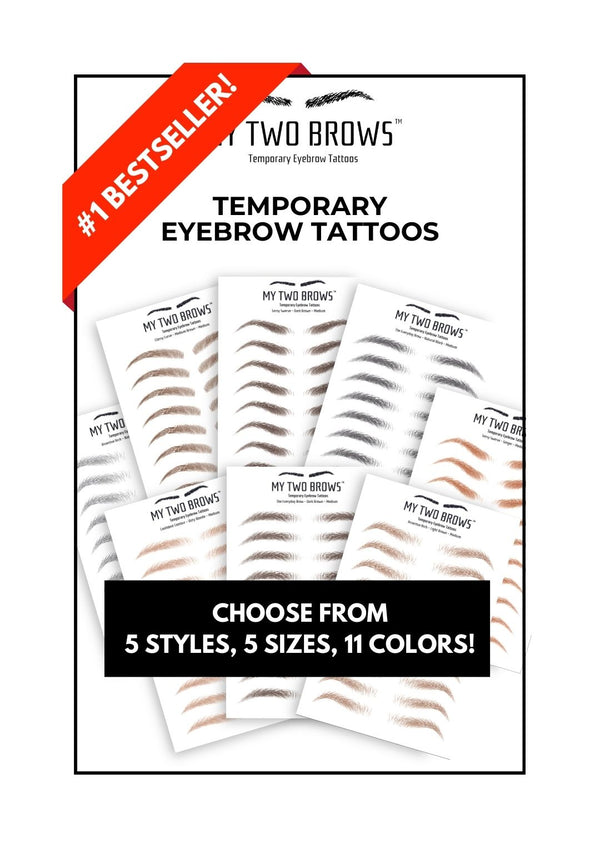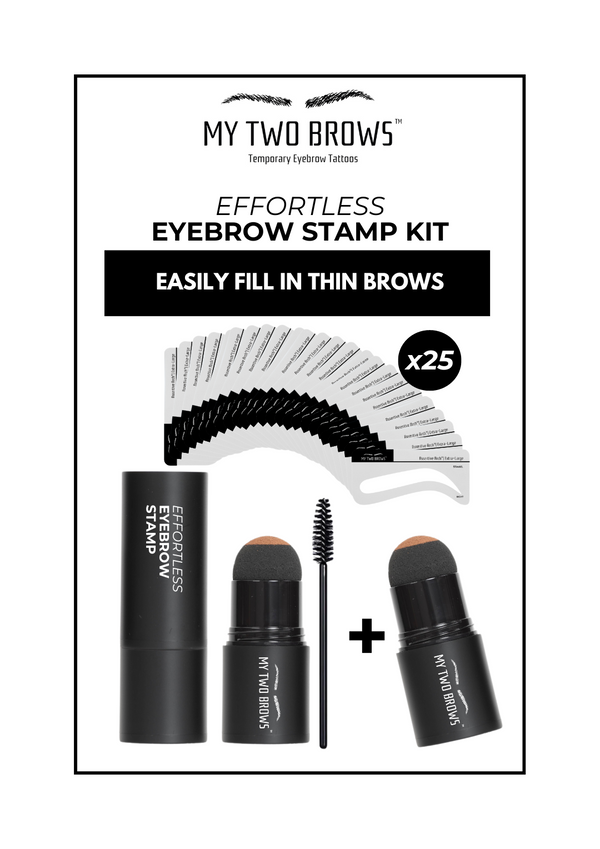
Everything You Need to Know About Permanent Eyebrow Tattooing: Microblading, Powder Brows, and More
Are you living with brow hair loss? No matter how long you’ve been trying to grow your hair out and have gotten used to the lifestyle, some days can still be tougher than others. It doesn’t always have to be that way, especially with today’s wide range of brow enhancement choices!
As of late, our favorite temporary brow shaper is the eyebrow stamp & stencil kit. No other tool has given us the power to restore natural-looking brows in under a minute and have them last up to 12 hours - practically covering a full day out and some change! We talk more about the wonders of the stamp and stencil kit below, but before getting into detail regarding temporary brow tools, let’s discuss permanent eyebrows and the options available in the brow industry today.
What is Microblading and How Does It Work?

It’s important to note that the only way to get permanently drawn eyebrows is through a permanent tattoo. The treatments we’ll be covering today are categorized as semi-permanent and we’ll start off with one of the most popular choices: Microblading.
Understanding the Microblading Process
Every microblading treatment starts with a thorough consultation with your chosen technician. During this conversation, you’ll cover all there is to know about the procedure, how you can prepare for the treatment, your ideal brow shape, and an evaluation of your skin type to better determine the best aftercare routine.
When it’s procedure day, your technician will numb the area using a topical cream and start applying the pigment using a hand-held tool with micro needles attached. Each needle carries pigment and is applied through swift motions to mimic hair-like strokes. The treatment can last up to 2 hours.
Microblading vs. Traditional Eyebrow Tattooing
Traditional tattooing is the least recommended brow enhancement procedure. The main difference between tattoos and microblading is that the former uses ink and is inserted into a deeper layer of the skin while microblading uses pigment and is applied only to a shallow layer. The depth of application affects how long the brows stay on, the more shallow the layer, the less permanent the results.
However, with traditional tattoo ink, you can expect your brows to discolor over time and permanently look unnatural on your skin.
Is Microblading Suitable for All Skin Types?
Microblading is suitable for all skin types. However, it is most effective on normal, dry, or combination skin types as the pigment may fade quicker on oily skin.
What Are Powder Brows and How Are They Different?

Powder brows is the most similar procedure to microblading, with a few factors that could make a huge difference in results.
Powder Brows vs. Microblading
Both microblading and powder brows produce natural-looking results. The difference between the two is the type of machine used in applying pigment and the technique employed. Powder brows are applied through a shading or pin-dot method that results in its powder-like gradient effect.
Benefits of Powder Brows
- Natural-looking results
- Brows appear soft
- It can be applied to any skin type
- Minimal pain
- Low-maintenance when initial aftercare period is done
- Lasts between 1 to 2 years
- Enhanced confidence and happiness
Who Should Consider Powder Brows?
Powder brows, also known as ombre brows, is a safe procedure fit for most individuals suffering from brow bald spots, thinning, or total hair loss. However, those who are pregnant, nursing, or have certain skin conditions should not get the procedure done to prevent complications.
What Are Combination Brows?

If you can’t choose between microblading and powder brows as a solution to your hair loss, you’re in luck as combination brows brings together the best of both procedures!
Combining Microblading and Powder Brows
Combination brows, or combo brows, start off with microblading hair-like strokes on the head of your eyebrow line towards the middle. From there, it slowly blends into the shadow technique and finishes with a gradient look towards the tail.
Advantages of Combination Brows
- Bold, full-bodied, yet soft brows all in one
- Natural-looking results
- It can be applied to any skin type
- Minimal pain
- Low-maintenance when initial aftercare period is done
- Lasts between 2-4 years
- Enhanced confidence and happiness
Who Can Benefit from Combination Brows?
Individuals of all skin types can benefit from getting the combination brows treatment. It’s a great procedure for those experiencing sparse brows or even have little to no hair left on their brow line and want to have more definition without having to apply eyebrow makeup every day.
What Should You Expect During the Eyebrow Tattooing Process?
While each of the semi-permanent procedures has its differences, the process is generally similar.
Initial Consultation and Design
All procedures start with an initial consultation to discuss you skin type, expectations, brow shape and arch, and other concerns or queries you may have regarding the treatment.
The Tattooing Procedure
Once everything is set, the actual procedure starts off with a numbing agent to ensure you are comfortable throughout the session. When the area is completely numb, your technician then starts to apply the pigment using specialized tools and techniques that result in your desired look.
Aftercare and Healing
For the first two weeks post-treatment, your brow area will be at its most vulnerable and sensitive state. While the healing process comes in phases and gets easier over time, you must adhere to the aftercare protocols your technician gives you. With proper support, your brows can heal faster and safer, lessening the risk of infections.
How Long Do Semi-Permanent Eyebrow Tattoos Last?

Most of the procedures last an average of two years. However, some may only stay on for a year, and others can even go up to four years. Below, we discuss the factors that affect the actual lifespan of your semi-permanent brows.
Factors Affecting Longevity
- Skin type
- Depth of application
- Aftercare practices
- Daily maintenance
- Diet and hydration
- Level of sun exposure
- Level of sweating
- Frequency of moisturizing
- Pigment quality
When to Schedule Touch-Ups
For any procedure, an initial touch-up is recommended around 6 weeks after the session. This is to ensure no bald spots and that your brow shape is accurate. Afterward, a maintenance touchup every 12 months (or sooner) is ideal.
Maintaining Your Eyebrows
After the initial two-week aftercare, maintenance of your semi-permanent brows is relatively low. Just ensure that you keep the area well moisturized, and clean, and only gently wash it to prevent premature fading. It will also help to minimize sun exposure and excessive sweating if you want them to last longer.
What Can You Try Instead of Permanent Brows?

If the thought of going through a semi-invasive procedure or having to adhere to a strict aftercare routine doesn’t suit you, we recommend temporary brow products instead such as our Temporary Eyebrow Tattoos and Eyebrow Stamp Kit.
Both products below can be applied in the comforts of your own home, in under 2 minutes, and can last you between 12 hours to 3 days. They are also waterproof, sweatproof, and smudge-proof but are just as easy to clean off as they are to put on.
Moreover, you can choose from a wide selection of brow shapes, sizes, and colors for that ultra-natural look!
Trouble with hair on your scalp? We’ve got Hair Thickening Fibers that will help cover up thinning areas, bald spots, or sparse patches.

You’re All Set!
We hope this guide gives you a better idea of what kind of treatment you want to pursue for permanent eyebrows, or if you prefer no-maintenance, pain-free, and affordable temporary brow alternatives. For more information on the best solutions to brow hair loss, check out My Two Brows today.






